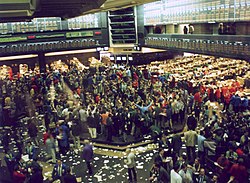 Commodity marketCommodity market refers to physical or virtual transactions of buying and selling involving raw or primary commodities. A soft commodity generally refers to commodities harvested as products like wheat, coffee,cocoa, sugar, corn, wheat, soybean and fruit traded in the commodity market. Hard commodities usually refer to commodities that are extracted such as (gold, rubber, oil)
Commodity marketCommodity market refers to physical or virtual transactions of buying and selling involving raw or primary commodities. A soft commodity generally refers to commodities harvested as products like wheat, coffee,cocoa, sugar, corn, wheat, soybean and fruit traded in the commodity market. Hard commodities usually refer to commodities that are extracted such as (gold, rubber, oil)
[1] While commodities may be grouped for regulation purposes etc., in large classes such as energy, agricultural including livestock, precious metals, industrial metals, other commodity markets, these are broken down into about a hundred primary commodities (soybean oil, recycled steel). Investors access about 50 major commodity markets worldwide uses growing numbers of exchanges with virtual transactions increasingly replacing physical trades.
A financial derivative in the commodity market is a financial instrument whose value is derived from a commodity as item or underlier. Derivatives trading employs various techniques to increase profit and manage risk.[2] Derivatives in the commodity market are assets that are either exchange-traded derivatives or over-the-counter (OTC) derivatives. With the increased diversity and complexity of commodities derivatives, new international institutions have emerged, such as clearing houses some withCentral Counterparty Clearing, which provide clearing and settlement services on a futures exchange, as well as off-exchange in the over-the-counter (OTC) market.
Derivatives in the form of the futures contracts are the oldest and most direct way of investing in commodities. Commodity market derivatives are securitized by physical assets or commodities.[2]Commodity markets can include direct physical trading and derivatives trading in the form of spot prices,forwards, futures and options on futures. Farmers have used a simple form of derivative trading in the commodity market for centuries for price risk management (p. 6).[3] In the basic agricultural futures contracts a farmer (the future seller) agrees with a counterparty, a future buyer to sell a set number of units of corn to a broker for a fixed future date at an agreed upon quality and price and point of delivery. If the price of corn drops the farmer is protected from losses thereby reducing risk. If the price rises the farmer loses potential profit. Derivative (finance)|Derivatives trading employs various techniques to increase profit and manage risk through hedging.[2]
One focus of this article is the relationship between simple commodity money and the more complex financial instruments of derivative trading,[2] such as futures contracts, Swaps (1970s-), Exchange-traded Commodities (ETC) (2003-), forward contracts. Futures are traded on regulated commodities exchanges. Over-the-counter (OTC) contracts in the commodity market are “privately negotiated bilateral contracts entered into between the contracting parties directly.”[4] [5] Although investors assume that commodity market derivatives are securitized by the physical assets or commodities, gold for example, the actual exposure to the physical commodity of gold has changed significantly since the emergence of financial instruments such as exchange-traded funds (ETFs) in 2003. ETF’s are based on electronic gold which does not entail the actual ownership of physical bullion, with its added costs of insurance and storage in bullion banks, such as the London bullion market. According to the World Gold Council, exchange-traded fund (ETFs) allow investors to be exposed to the gold market without the risk of price volatility associated with gold as a physical commodity.
